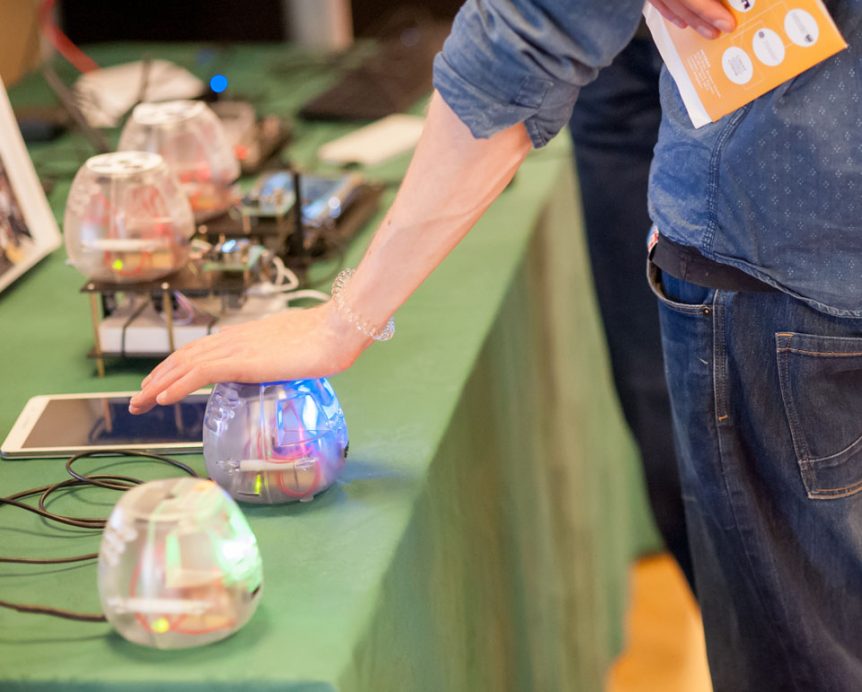Archive, Event
PETRAS URB November 2017
The 10th of November saw the fourth meeting of researchers and user partners coming together to discuss the progress and direction of the PETRAS hub.
Following a welcome from the PETRAS director, Prof. Jeremy Watson CBE, the keynote speech was given by Di Minestrone, a WIRED innovation fellow and founder of the Human Harp. Di is a prominent figure on the international digital art scene and gave a provocative talk, providing an alternative view of the progression of technology from an artist’s perspective.
Prof. Watson continued the day by giving a round up of how the research hub is progressing hi-lighting, the extension of the PETRAS project portfolio to now include over 50 active projects and the rich number of industry and public sector collaborators which now totals over 100 organisations.
Before Lunch Prof. Emil Lupu, deputy director of PETRAS, chaired a panel discussion entitled ‘A secure and resilient IoT economy’. The panel consisted of Dr Irina Brass from UCL, Prof. Nigel Davies of Lancaster University, Prof. Michael Huth based at Imperial College, Dr Mike Short CBE, Chief Scientific Advisor at the Department for International Trade, and Pete Rai, Principal Engineer at CISCO.
Summarising the panel discussion Prof. Lupu said: “Whilst we are making progress towards addressing the security and resilience issues, the size of the challenge remains considerable. Leveraging opportunities for rapid growth whilst simultaneously managing risk requires a continuously changing balance of technical innovation, policy intervention, business transformation and above all education.”
The event was the first time that newly funded PETRAS projects, from the Strategic Research Fund, were brought together and able to present their research vision and progress to user partners. The presence of such a large number of research projects made for an extremely lively and informing exhibition space that was packed with posters, demonstrations, displayed devices and videos.

RECOPS INVESTIGATES HOW IOT CAN TRANSFORM OUR INTERACTION WITH PUBLIC SPACES AND PUBLIC INFRASTRUCTURES.
During the lunch break and exhibition, there was an incredible amount of discussions taking place with many PETRAS academics, Industry and Public sector attendees stating how they had made new connections and will be following up in the coming weeks. Among the many engaging demonstrations of work, one which caught people’s attention was from the ReCoPS project who had brought along sensors, devices and a live demo. They showed how they are using these devices when investigating the use of IoT to transform out interaction with public spaces and infrastructures.
After lunch, the attendees reconvened in the auditorium to discuss the development of live demonstrators stemming from the portfolio of PETRAS research. Graça Carvalho, PETRAS Impact Champion, announced that between now and February 2019 PETRAS will develop several ‘demonstrators’, these will be live deployments of research outputs from the PETRAS projects and will be produced in collaboration with academic researchers and industry.
It was described that the demonstrators will focus on several areas of the IoT, namely; Living in IoT, which will focus on the home environment and public spaces; Working in IoT, looking at operational control in industry 4.0 and smart infrastructures; Mobility in IoT, which will align with new transportation paradigms and autonomous vehicles; and Data in IoT, where a demonstrator will be developed around the sharing of IoT datasets.
Following the introduction from Mrs Carvalho several panels convened to discuss potential visions for each of the demonstrator. The panels took it, in turn, to provide presentations from members of the research body, as well as industry partners, before opening up discussions to the floor.
Closing the day Dr Mike Short, Chair of the PETRAS steering board, thanked all the attendees and expressed his enthusiasm for the outputs being generated from the hub. He concluded by motivating collaborators and researchers alike to continue with our current progress.

